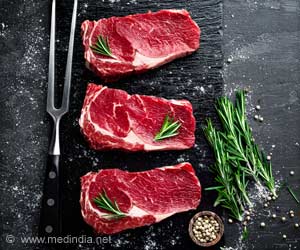“Most of the focus on red meat intake and health has been around dietary saturated fat and blood cholesterol levels,” said co-lead author of the study Meng Wang, Ph.D., a postdoctoral fellow at the Friedman School of Nutrition Science and Policy at Tufts University in Boston. “Based on our findings, novel interventions may be helpful to target the interactions between red meat and the gut microbiome to help us find ways to reduce cardiovascular risk.”
How Does Red Meat Affect Gut Microbiome?
Previous research has found that certain metabolites chemical byproducts of food digestion are associated with a greater risk of cardiovascular disease. One of these metabolites is trimethylamine N-oxide (TMAO), which is produced by gut bacteria to digest red meat that contains high amounts of the chemical L-carnitine.
Advertisement
High blood levels of TMAO in humans may be associated with higher risks of CVD, chronic kidney disease, and Type 2 diabetes. However, whether TMAO and related metabolites derived from L-carnitine may help explain the effects of red meat intake on cardiovascular risk, and to what extent they may contribute to the cardiovascular risk associated with meat consumption, is still unknown.
To understand these questions, the researchers conducting this study measured levels of the metabolites in blood samples. They also examined whether blood sugar, inflammation, blood pressure, and blood cholesterol may account for the elevated cardiovascular risk associated with red meat consumption.
Details of the Study
Study participants included nearly 4,000 of the 5,888 adults initially recruited from 1989 to 1990 for the Cardiovascular Health Study (CHS). The participants selected for the current study were free of clinical cardiovascular disease at the time of enrolment in the CHS, an observational study of risk factors for cardiovascular disease in adults aged 65 or older.
The CHS follows 5,888 participants recruited from four communities: Sacramento, California; Hagerstown, Maryland; Winston-Salem, North Carolina; and Pittsburgh, Pennsylvania. The average age of participants at enrollment was 73, nearly two-thirds of participants were female and 88% of participants self-identified as white. The median follow-up time for participants was 12.5 years, and up to 26 years in some cases. At the follow-up appointment, participants’ medical history, lifestyle, health conditions, and sociodemographic characteristics such as household income, education, and age were assessed.
Several blood biomarkers were measured at the start of the study and again in 1996-1997. The fasting blood samples stored frozen at -80 ˚C were tested for levels of several gut-microbiome linked to red meat consumption including TMAO, gamma-butyrobetaine, and crotonobetaine.
Additionally, all study participants answered two validated food-frequency questionnaires about their usual dietary habits, including intake of red meat, processed meat, fish, poultry, and eggs, at the start of the study and again from 1995 to 1996. For the first questionnaire, participants indicated how often, on average in the previous 12 months, they had eaten given amounts of various foods, ranging from ‘never’ to ‘almost every day or at least five times per week,’ based on medium portion sizes, which varied based on the food source. The second questionnaire used a ten-category frequency of average intake over the past 12 months, ranging from ‘never or less than once per month’ to ‘six+ servings per day,’ with defined standard portion sizes.
Results of the Study
For the current analyses, the researchers compared the risk of cardiovascular disease among participants who ate different amounts of animal source foods (i.e., red meat, processed meat, fish, chicken, and eggs). They found that eating more meat, especially red meat and processed meat, was linked to a higher risk of atherosclerotic cardiovascular disease – a 22% higher risk for about every 1.1 servings per day.
According to the authors, the increase in TMAO and related metabolites found in the blood explained roughly one-tenth of this elevated risk. They also noted that blood sugar and general inflammation pathways may help explain the links between red meat intake and cardiovascular disease.
Blood sugar and inflammation also appear to be more important in linking red meat intake and cardiovascular disease than pathways related to blood cholesterol or blood pressure. Intake of fish, poultry, and eggs was not significantly linked to a higher risk of cardiovascular disease.
“Research efforts are needed to better understand the potential health effects of L-carnitine and other substances in red meat such as heme iron, which has been associated with Type 2 diabetes, rather than just focusing on saturated fat,” Wang said.
Limitations of the Study
The study had several limitations that may have affected its results. The study was observational, meaning it could not control for all risk factors for cardiovascular disease, and may not prove the cause and effect between meat consumption and cardiovascular disease or its mediation by gut microbe-generated chemicals. Additionally, food consumption was self-reported, so errors in reporting were possible. And, as most of the study participants were older, white men and women in the United States, the findings may not apply to populations that are younger or more racially diverse.
Source: Eurekalert



